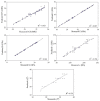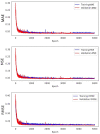A Deep Learning Method for the Prediction of the Index Mechanical Properties and Strength Parameters of Marlstone
- PMID: 36234239
- PMCID: PMC9572758
- DOI: 10.3390/ma15196899
A Deep Learning Method for the Prediction of the Index Mechanical Properties and Strength Parameters of Marlstone
Abstract
The index mechanical properties, strength, and stiffness parameters of rock materials (i.e., uniaxial compressive strength, c, ϕ, E, and G) are critical factors in the proper geotechnical design of rock structures. Direct procedures such as field surveys, sampling, and testing are used to estimate these properties, and are time-consuming and costly. Indirect methods have gained popularity in recent years due to their time-saving and highly accurate results, which are comparable to those obtained through direct approaches. This study presents a procedure for establishing a deep learning-based predictive model (DNN) for obtaining the geomechanical characteristics of marlstone samples that have been recovered from the South Pars region of southwest Iran. The model was implemented on a dataset resulting from the execution of numerous geotechnical tests and the evaluation of the geotechnical parameters of a total of 120 samples. The applied model was verified by using benchmark learning classifiers (e.g., Support Vector Machine, Logistic Regression, Gaussian Naïve Bayes, Multilayer Perceptron, Bernoulli Naïve Bayes, and Decision Tree), Loss Function, MAE, MSE, RMSE, and R-square. According to the results, the proposed DNN-based model led to the highest accuracy (0.95), precision (0.97), and the lowest error rate (MAE = 0.13, MSE = 0.11, and RMSE = 0.17). Moreover, in terms of R2, the model was able to accurately predict the geotechnical indices (0.933 for UCS, 0.925 for E, 0.941 for G, 0.954 for c, and 0.921 for φ).
Keywords: deep learning; geomechanical properties; marlstone; rock material; rock strength parameters.
Conflict of interest statement
The authors declare that they have no conflict of interest.
Figures









References
-
- Jaeger J., Cook N.G., Zimmerman R. Fundamentals of Rock Mechanics. Wiley-Blackwell; Hoboken, NJ, USA: 2007.
-
- Mogi K. Experimental Rock Mechanics. T&F Books; Abingdon, UK: 2009.
-
- Fereidooni D. Determination of the geotechnical characteristics of hornfelsic rocks with a particular emphasis on the correlation between physical and mechanical properties. Rock Mech. Rock Eng. 2016;49:2595–2608. doi: 10.1007/s00603-016-0930-3. - DOI
-
- Azarafza M., Akgün H., Asghari-Kaljahi E. Assessment of rock slope stability by slope mass rating (SMR): A case study for the gas flare site in Assalouyeh, South of Iran. Geomech. Eng. 2017;13:571–584. doi: 10.12989/gae.2017.13.4.571. - DOI
-
- Heidari M., Mohseni H., Jalali S.H. Prediction of uniaxial compressive strength of some sedimentary rocks by fuzzy and regression models. Geotech. Geol. Eng. 2018;36:401–412. doi: 10.1007/s10706-017-0334-5. - DOI
LinkOut - more resources
Full Text Sources
Miscellaneous

